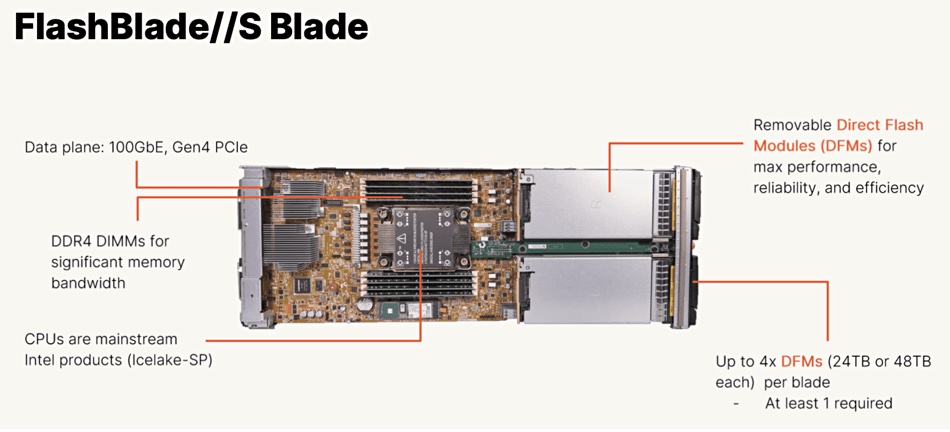Both IBM and Pure Storage make all-flash storage systems with their own proprietary flash drives. How do they stack up?
The two storage stars have rejected commercially available SSDs, choosing instead the expense of developing their own flash drive hardware and software to gain flash capacity, endurance, and operational advantages. In general, IBM’s flash drives are drive controller-centric while Pure’s drives, by contrast, are relatively dumb – for want of a better word – at the drive controller level, but intelligent at the system level.
IBM’s drive is called the Flash Core Module (FCM). It’s currently in its fourth generation and available with 4.8, 9.6, 19.2 and 38.4TB raw capacities inside its 2.5-inch, 15mm enclosure. These drives have a PCIe 4 interface.

Onboard hardware compression is used to give the 4.8 and 9.6TB models an effective 21.99TB capacity, the 19.2TB drives become an effective 43.98TB drive, while the top-end 38.4TB product is a 87.96TB drive with compression, 2.3x larger.
FCM generations 1–3 use floating gate NAND technology whereas FCM 4 moved to charge trap technology (Micron 176-layer NAND dies).
Inbuilt Ransomware Threat Detection “is a process that identifies and responds to security threats before they can damage data or systems. The FCM 4 collects detailed statistics on every I/O operation (IOP) for each virtual disk (Vdisk). This data is then intelligently summarized for efficient processing. The FCM 4 transmits this summary to Storage Virtualize, which relays it to an AI-powered inference engine. This engine can identify unusual activity, like potential ransomware attacks, in under a minute. Upon detection, an immediate alert is sent to IBM Storage Insights Pro, allowing for swift action. Additionally, the information can be shared with IBM Storage Defender if available, further strengthening your security posture.”

Pure Storage builds DirectFlash Modules (DFMs) and mounts up to four of them on storage blades. The DFMs use QLC flash dies. In 2022, a FlashBlade storage blade had DDR4 memory DIMMs, PCIe 4 connections to the DFMs, and a 100GbitE data plane. A Futurum report states: “FlashBlade includes inline compression for all data stored on an individual blade done in software. Pure Storage expects a 3:1 reduction across most file data with exceptions in some vertical market data types. Compression is handled differently between the S200 blade and the S500 blade. The S500 blade reduces compression to reduce computational overhead and increase performance.”
Pure claims its system-level management of DFMs can improve reliability up to 5x compared to conventional SSDs, and extend the drive’s lifetime. Garbage collection, sparing, and wear levelling are all carried out at a system rather than drive level, “eliminating duplicate efforts and processes that happen across every drive in a traditional system.”

This means that its DFMs don’t need much DRAM as they “are effectively just a collection of flash chips with FTL done at the system-wide level in Pure’s controller and its software, instead of at the SSD level as in other all-flash array storage systems.”
It also claims its DFMs “consume from 39 percent to 54 percent fewer watts per terabyte than our closest competitors today.”
Pure Storage was shipping 24 and 48TB DFMs in 2023 and added a 75TB drive earlier this year, with 150TB drives due to follow them in a year or less time – possibly later this year – and 300TB drives after that, probably during 2026. Its roadmap envisages 300 and 600TB DFMs, even extending to 1.2 petabyte drives. A supplier may introduce a 128TB SSD at the August FMS 2024 event. Pure Storage will beat that at the raw capacity level with its 150TB DFM.

IBM has not published a public FCM roadmap. It has historically doubled capacity, and on this basis the next capacity point will likely be 76.8TB with a maximum effective capacity of 230.4TB, assuming no compression advances or other added data reduction methods.
The Pure FlashArray DFMs do not have onboard compression. Instead, Pure arrays, like its FlashArray, provide data reduction from their Purity OS and have a system-level compressing FPGA (DCA card) to do compression work.
Pure’s data reduction includes thin provisioning, zero detection, and unmap. Its FlashArray is claimed to deliver “an industry-leading 5:1 data reduction with a total efficiency of 10:1 (including thin provisioning).” That would mean a 48TB DFM would have an effective capacity of up to 240TB at 5x data reduction.
The FlashBlade//S systems have DFM blade-level compression working at the 3:1 level – rather less.
The DFMs do not have onboard ransomware threat detection. Pure provides immutable snapshots, so data can be recovered if there is a ransomware attack.
Summary
Get an IBM FlashCore Module product guide here. Here’s our summary table of the IBM and Pure Flash drives:









